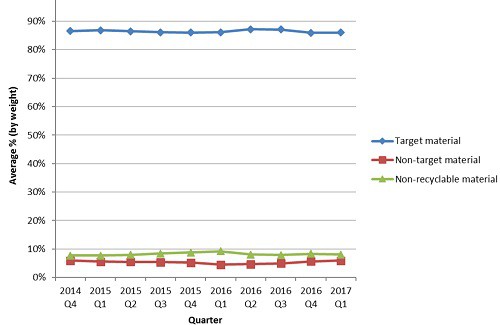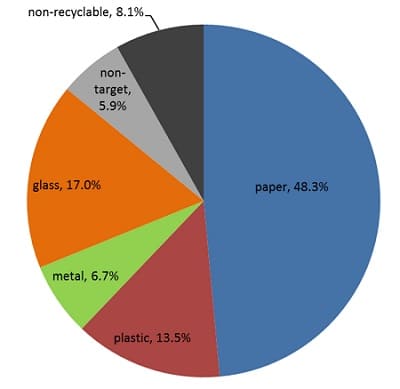 Data on the quality of material received at materials recycling facilities (MRFs) for the first quarter of 2017 shows that the volume of ‘target’ material received at facilities has remained relatively static at close to 87%.
Data on the quality of material received at materials recycling facilities (MRFs) for the first quarter of 2017 shows that the volume of ‘target’ material received at facilities has remained relatively static at close to 87%.
Published on WRAP’s Materials Facility Reporting Portal this week the data charts the volume of ‘target’ and ‘non-target’ material received at 95 registered MRFs in England and Wales from January to March 2017.
Fluctuations in input stream samples in England Q4 2014 – Q1 2017
It is the tenth set of data to have been published since changes to the law that required MRF operators to report the composition of material taken into and out of facilities.
Data
The data shows that for MRFs in England, the average composition of target material in input waste streams has stayed relatively static since Q4 2014.
According to the data, the average percentage (by weight) of target material received by responding MRFs for the three-month period at the start of 2017 was 86% for England and 88.5% for Wales.
This indicates a 0.1% increase for England and a 1.2% decrease for Wales compared to the previous quarter.
In England, 88 facilities notified the Environment Agency in accordance with the Regulations for Jan-Mar 2017 and 83 submitted a quarterly data return. In Wales, 12 facilities notified Natural Resources Wales and all 12 submitted data.
The waste supplied to the responding MRFs in England was attributed directly to 198 local authorities and 226 other suppliers, such as waste management companies.
WRAP found the total tonnage of mixed material entering the MRFs in England in Q1 2017 was 855,900 tonnes – around 28,506 tonnes or 3.2% less than the previous quarter.
Paper
Samples taken from these MRFs indicated that out of the total 86% target material, paper made up the largest percentage at 48.3%, with plastics (13.5%), metals (6.7%) and glass (17%).
Non-target material (material that is capable of being recycled but is not a target material for that facility) made up 5.9%. And, 8.1% of material was non-recyclable.

Average composition of sampled input material, Jan-Mar 2017 (England)
According to WRAP, the total tonnage of Specified Output Material (SOM) leaving these MFs in Q1 2017 was 676,863 tonnes – an increase of 42,663 tonnes compared to the previous quarter, and the highest figure since reporting began in Q4 2014.
SOM
The average percentage of target material of responding MFs is 90.3 % or higher for all of the four main SOM (paper, plastic, metal and glass). The data shows there has been some variation in the average percentage of targeted materials over the last ten quarters.
Data on the level of target and non-target material has been recorded by MRF operators since requirements to begin sampling and reporting the quality of loads came into effect in October 2014.
The figures, which were published on the WRAP Materials Facility portal, are the tenth set published under sampling and reporting obligations for MRF operators receiving more than 1,000 tonnes of mixed waste each year.
The regulations aim to bring ‘more transparency’ to the sorting and recycling of household waste by requiring MRF operators receiving more than 1,000 tonnes of mixed waste each year have been required to report the quality of input and output material sorted at facilities.

